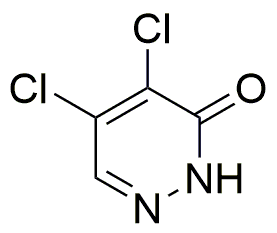4,5-Dichloro-3(2H)-pyridazinone is widely utilized in research focused on:
- Agricultural Chemistry: This compound serves as a key intermediate in the synthesis of herbicides, helping to control unwanted plant growth and improve crop yields.
- Pharmaceutical Development: It is used in the creation of various pharmaceuticals, particularly in the development of anti-inflammatory and analgesic medications, offering potential benefits over traditional compounds.
- Material Science: This chemical is involved in the formulation of specialty polymers and coatings, enhancing durability and resistance to environmental factors.
- Analytical Chemistry: It acts as a reagent in various analytical techniques, aiding in the detection and quantification of other substances, which is crucial for quality control in manufacturing.
- Biochemistry: The compound is utilized in biochemical assays and research, contributing to the understanding of metabolic pathways and enzyme functions, which is essential for advancing medical research.
Informations générales
Propriétés
Sécurité et réglementation
Applications
4,5-Dichloro-3(2H)-pyridazinone is widely utilized in research focused on:
- Agricultural Chemistry: This compound serves as a key intermediate in the synthesis of herbicides, helping to control unwanted plant growth and improve crop yields.
- Pharmaceutical Development: It is used in the creation of various pharmaceuticals, particularly in the development of anti-inflammatory and analgesic medications, offering potential benefits over traditional compounds.
- Material Science: This chemical is involved in the formulation of specialty polymers and coatings, enhancing durability and resistance to environmental factors.
- Analytical Chemistry: It acts as a reagent in various analytical techniques, aiding in the detection and quantification of other substances, which is crucial for quality control in manufacturing.
- Biochemistry: The compound is utilized in biochemical assays and research, contributing to the understanding of metabolic pathways and enzyme functions, which is essential for advancing medical research.
Documents
Fiches de données de sécurité (FDS)
La FDS fournit des informations de sécurité complètes sur la manipulation, le stockage et l’élimination du produit.
Spécifications du produit (PS)
Le PS fournit une description complète des propriétés du produit, notamment sa composition chimique, son état physique, sa pureté et les exigences de stockage. Il détaille également les plages de qualité acceptables et les applications prévues du produit.
Certificats d'analyse (COA)
Recherchez des certificats d'analyse (COA) en saisissant le numéro de lot du produit. Les numéros de lot et de lot se trouvent sur l'étiquette d'un produit, après les mots « Lot » ou « Lot de fabrication ».
Numéro de catalogue
Numéro de lot/série
Certificats d'origine (COO)
Ce certificat d'exploitation confirme le pays dans lequel le produit a été fabriqué, et détaille également les matériaux et composants utilisés et s'il est issu de sources naturelles, synthétiques ou autres sources spécifiques. Ce certificat peut être requis pour les douanes, le commerce et la conformité réglementaire.
Numéro de catalogue
Numéro de lot/série
Fiches de données de sécurité (FDS)
La FDS fournit des informations de sécurité complètes sur la manipulation, le stockage et l’élimination du produit.
DownloadSpécifications du produit (PS)
Le PS fournit une description complète des propriétés du produit, notamment sa composition chimique, son état physique, sa pureté et les exigences de stockage. Il détaille également les plages de qualité acceptables et les applications prévues du produit.
DownloadCertificats d'analyse (COA)
Recherchez des certificats d'analyse (COA) en saisissant le numéro de lot du produit. Les numéros de lot et de lot se trouvent sur l'étiquette d'un produit, après les mots « Lot » ou « Lot de fabrication ».
Numéro de catalogue
Numéro de lot/série
Certificats d'origine (COO)
Ce certificat d'exploitation confirme le pays dans lequel le produit a été fabriqué, et détaille également les matériaux et composants utilisés et s'il est issu de sources naturelles, synthétiques ou autres sources spécifiques. Ce certificat peut être requis pour les douanes, le commerce et la conformité réglementaire.


